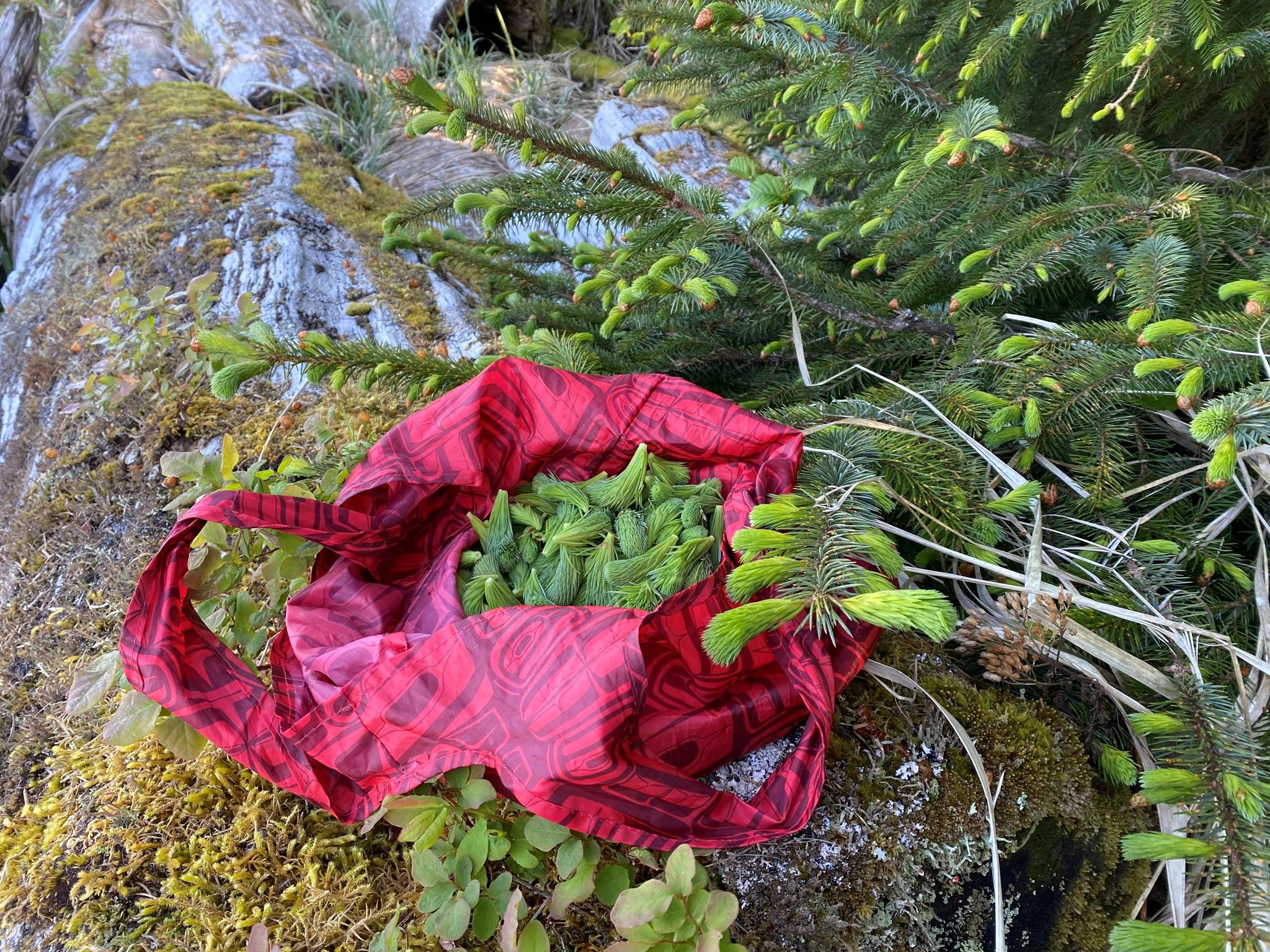Vivian Faith Prescott
For the Capital City Weekly
In my hoodie and Xtratufs, I lean into the spruce tree, becoming a living part of its record of this sunny day, the mild spring, and me gently pinching off its spruce tips. “Gunalcheesh, Giitu.”
Across from me, my dad leans against a branch and Oscar, my border collie, is lying down in the grass. We’ve strolled to this grove across a boardwalk built nearly 20 years ago by my dad and his Forest Service crew. The boardwalk still holds the weight of campers, picnickers, hikers and spruce tip foragers. Stepping off the boardwalk, we walk a gravel path leading through a forest of young Sitka spruce trees adorned with spruce tips. Beyond the trees, a mossy alpine campsite opens up to a blue sky. The camping area is complete with a picnic table, outhouse, a fire-pit, and a spectacular view of Anita Bay.
[Planet Alaska: Carrying on our traditions]
I smile and breath in the beauty of lime green buds — spruce tip bathing. The forest air is filled with terpenes, and other aromatic compounds found in the trees. In Indigenous communities, forest bathing is not a new concept or a revolutionary fad. Though the term shinrin-yoku, meaning “taking in the forest atmosphere” or “forest bathing,” was coined in Japan in the 1980s, this way of being is a part of many Indigenous cultures’ traditional ecological knowledge. In the Tlingit culture there are tree ceremonies and stories related to trees like the Woman-Who-Married-a-Tree, wisdom that illustrates relationships to nature — A káx yan aydél wé tl’átgi — We are stewards of the air, land and sea. Being stewards means taking care of the natural world and ourselves, including our families and community. Traditional healers often prescribe walks or ventures into the forest.
Harvesting, I reach for the smaller tips. The perfect spruce tip is tightly bound needles without the brown papery casing. The best time to eat them whole is when the casing is still on and the needles are soft and tart. Remove the casing and eat them. I pluck a bright green tip from the tree with my gloved hand and pick another and another. I plop them into my cedar bark bucket, which is half full already. Spruce tip bathing occurs during one of my favorite times of the year, when I’m in need of boosting my immune system and contentment quotient. Spruce tip bathing increases energy level, improves sleep and reduces stress — It’s good medicine.
[Planet Alaska: Eat your trees]
I move to a larger tree. The Forest Service has trimmed the lower branches so I have to reach higher. My plan is to pick enough spruce tips for sharing and eating all year round. I also want to make my favorite spruce tip/fireweed jelly blend to share. Mickey’s Fishcamp, where I live, is all about sharing food, sharing knowledge and traditions. Every spring, we venture out to gather enough spruce tips for our family and gift to the tribe and elders. We make spruce tip naan, spruce tip iced tea, spruce tip brownies, put spruce tips in spring rolls and sauces and baked goods.
My bucket fills to the top with spruce tips and I pour the bucket of tips into a waterproof cloth bag. I slip the bag in my backpack and continue picking. Spending time in the forest, or spruce tip bathing, can boost your immune system. Spruce tip bathing can lower anxiety, depression and stress, lower blood pressure and improve your mood. In my Sámi tradition, being present in the forest calms our thoughts and the noise of life. It often gives us a new perspective. The forest embraces us and there’s a sense of belonging. In Sámi culture it’s called Iellema Gaerdda—The-Circle-of-Life. Nature is at the center of our Sámi spiritual traditions. Our values stress we are nature. Spruce tip bathing provides a mental rest: choose the tip, pick, plunk it into the bucket; choose the tip, pick, plunk it into the bucket, repeat and the whole time inhaling a rich forest scent and maybe thinking about making spruce tip pesto.
Similar to my Sáminess, part of my Finnish identity is to savor silence and calmness. We call it Finn-relaxing, meaning, I’m home among the quiet activity of spruce tip bathing. My Finn-sense gets out of balance if I’m away from a forest for too long. There are terms for the longing you get from not being in nature: ecoanxiety, eco-paralysis, solastagia, etc. Thankfully, living in Southeast Alaska, we’re either living in a forest or surrounded by trees. We can look out our windows at the hillside forest and the neighbor has a big spruce tree in their yard. In the winter, when it’s too cold or nasty to go out and I’m longing for spring, I’ll get out my packaged spruce tips from the freezer and plop a few tips in a glass of water to let them steep. Spruce tip water is good for you and invigorating. When I drink it I can almost hear the thrush singing.
Now, in the bud burst, I’m surrounded by bright green spruce tips, and there’s a feeling of a life bursting forth around me. A clump of lady ferns and feather moss is beside me, and beyond is skunk cabbage and rusty leaf menziesia. I am part of the forest’s understory today, spruce tip bathing among salmonberry shoots, hemlock seedlings and liverworts.
• Wrangell writer and artist Vivian Faith Prescott writes “Planet Alaska: Sharing our Stories” with her daughter, Vivian Mork Yéilk’. It appears twice per month in the Capital City Weekly.

